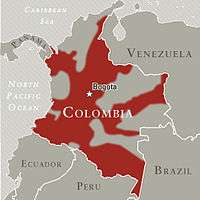Operation Traira
| Operation Traira | |||||||
|---|---|---|---|---|---|---|---|
| Part of the Colombian conflict (1964–present) and War on Drugs | |||||||
 Taraíra River | |||||||
| |||||||
| Belligerents | |||||||
| |||||||
| Commanders and leaders | |||||||
|
| unknown | ||||||
| Strength | |||||||
|
Brazilian Government Effective from:
Colombian Government : 1 Infantry Battalion | ~ 200 guerrillas | ||||||
| Casualties and losses | |||||||
| Brazilian: 3 soldiers killed and 9 injured |
62 guerrillas killed over 100 captured | ||||||
| 2 civilians killed | |||||||
Operation Traira was the response of the Brazilian Armed Forces, with support from the Colombian Army, to an attack on their detachment on the bank of the Traira River by FARC in February 1991.[1][2]
Background
The Traíra Detachment had been established in May 1990, 300 miles north of Tabatinga on the Traira River, which forms part of the border between Brazil and Colombia.[2] Its purpose was to confront the lawless situation in the region caused by the presence of illegal Brazilian and Colombian gold miners. It was under the command of the then 1st Border Command of the 1st Special Border Battalion, Tabatinga. Their mission was to maintain law and order by deporting Colombian miners and stopping Brazilian miners from entering the area.[1]
Guerrilla incursion
On February 26, 1991, a group of 40 guerrillas of the Revolutionary Armed Forces of Colombia, who called itself "Simon Bolivar Command", crossed the border from Colombia to Brazil and raided the Traíra detachment of the Brazilian Army, which was in semi-permanent installations and had less troops than the attacking guerrilla column. Intelligence operations claim that the attack was motivated by repression by the border detachment of illegal mining in the region, one of FARC's funding sources. During the attack three Brazilian soldiers died and nine were injured. Two illegal Colombian miners who were detained at the camp also died.[1] Various weapons, ammunition and equipment were stolen.
Military response
Immediately the Brazilian Armed Forces, authorized by President Fernando Collor de Mello and with the knowledge and support of Colombian President César Gaviria, secretly unleashed Operation Traíra, in order to recover the stolen arms and discourage further attacks;
Brazilian Air Force: The Brazilian Air Force supported Operation Traíra with six transport helicopters H-1H troops, six soil attack aircraft AT-27 Tucano and logistics support aircraft C-130 Hercules and C-115 Buffalo.
Brazilian Navy: The Navy of Brazil supported the Traíra operation with a River Patrol ship, which was based in Vila Bittencourt, cooperating with the logistical support and ensuring the security of the region.
Brazilian Army: The Brazilian Army sent its main elite troops, special forces elements and commandos of the Battalion of Special Forces (current 1st Battalion of Special Forces and the 1st Command Action Battalion), as well as jungle warriors before 1st Special Battalion Border, to attack the guerrilla base that was in Colombian territory, near the border. They were also supported by soldiers of the 1st Infantry Battalion of Selva, the main unit of the Amazon Military Command. The Army Aviation Command was present by providing the means of transport used by the combatants employed in the mission, four maneuvering helicopters Eurocopter AS565 Panther, 2 recognition helicopters and Eurocopter AS350 Écureuil attack.
Colombian Army: The Colombian Army supported the Traíra operation with the battalion Bejarano Muñoz, is believed to have blocked the escape route of the guerrillas if they tried to escape the Brazilian Army attack. The balance of operation Traíra was sixty-two guerrillas killed, more than one hundred captured, all weapons and equipment recovered.
Aftermath
Since then, there were no more raids of the FARC in Brazil, as well as attacks on Brazilian military.
References
- 1 2 3 de Souza Pinheiro, Alvaro; Mendel, William W. (July 1995). "Guerrilla in The Brazilian Amazon". Foreign Military Studies Office. Retrieved 21 September 2015.
- 1 2 Brooke, James (March 7, 1991). "Brazilian Troops Kill 3 Colombian Guerrillas". New York Times. Retrieved 21 September 2015.